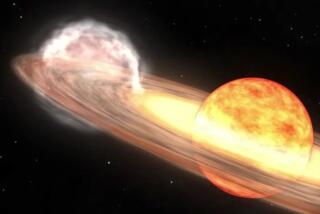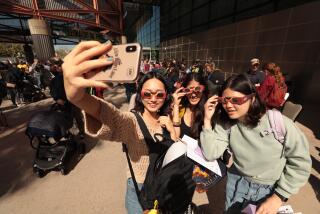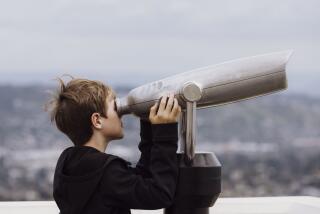A Heavenly Gift for Stargazers: Partial Eclipse for Christmas
Invoking the magic of celestial mechanics, there is a holiday bonus for nearly everyone in North America this morning--a partial eclipse of the sun on Christmas Day.
The eclipse, as seen from the Los Angeles area, will begin at 7:37 a.m., when the moon begins to move in front of the sun. At maximum eclipse, at 8:23 a.m., only a small portion of the upper left part of the sun will be covered. The eclipse will end at 9:13 a.m. It is important to use safe solar filters or projection techniques to observe the eclipse.
The Christmas eclipse is the first on the holiday since 1954 and the last until the 24th century.
Unless you’re looking for it, you’re not likely to notice anything of this yule eclipse. Too little of the sun’s energy will be blocked to cause any noticeable dimming of the light or cooling of temperatures.
“Probably the most significant thing about this eclipse, other than the date, is simply that the average person doesn’t get a chance to see a solar eclipse every day,” said Fred Espenak, an eclipse expert at the National Aeronautics and Space Administration’s Goddard Space Flight Center in Greenbelt, Md.
That chance arrives this morning. The sun, four days past the winter solstice, will hang low in the southern sky.
The “new” moon, invisible with its “night” side facing Earth, will begin to pass between Earth and the sun, blocking a growing slice of the sun’s light. The edge, or “limb,” of the moon will encroach first on the top, right-hand edge of the sun’s disk, then slide slowly to its center.
At its maximum position, the sun will look something like the broad grin of the Cheshire cat from “Alice in Wonderland.”
Then the moon will retreat toward the upper left-hand edge of the sun’s disk, and the eclipse will end.
Throughout the event, the sun will remain too bright to be observed directly. Anyone who tries could suffer serious eye injury or blindness. But observers using simple cardboard pinhole projectors or sun-safe filters can watch all phases of the eclipse safely.
Do not use sunglasses, smoked glass, photo film or 3-D glasses. Although some might reduce the visible light passing through, they are unreliable protection and might do little to protect your eyes from damaging infrared rays you cannot see.
The quickest and cheapest safe solution is a pinhole projector.
“You’ll need two pieces of cardboard, one of them white,” NASA’s Espenak said. “The white piece is your ‘movie screen’ for the eclipse.”
Poke a small pinhole in the second piece of cardboard, and--with your back to the sun--hold it several feet in front of the white piece so that the sun’s light shines through the pinhole onto the white cardboard. A small image of the eclipsed sun should appear.
An astronomy magazine or a visit to Espenak’s Web site (https://sunearth.gsfc.nasa.gov/eclipse) are good places for information.
In the meantime, here are some sure-fire eclipse facts for Christmas party banter:
* This is the last solar eclipse of the second millennium.
* It is the first Christmas Day eclipse since 1954, and the last until 2307.
* The next partial solar eclipse visible here will be Dec. 14, 2001. But that one will be short-lived, beginning shortly before the sun sets.
* The next total eclipse of the sun in the continental United States will be Aug. 21, 2017.
More to Read
Sign up for The Wild
We’ll help you find the best places to hike, bike and run, as well as the perfect silent spots for meditation and yoga.
You may occasionally receive promotional content from the Los Angeles Times.






